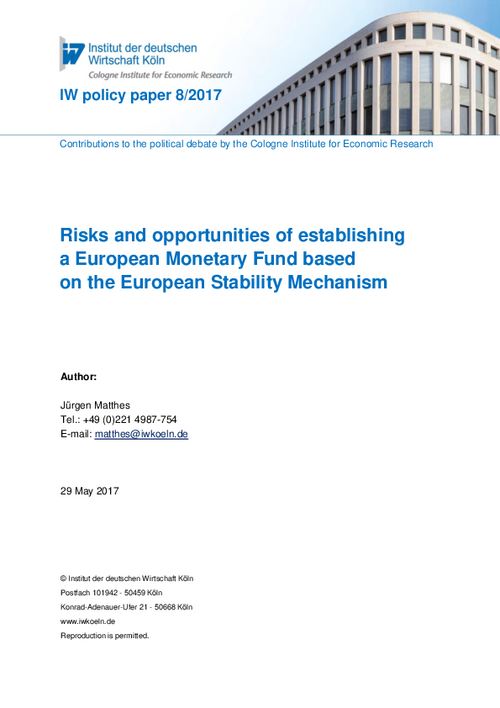The French presidential elections could lead to more fiscal integration in the euro area. The proposal to establish a European Monetary Fund (EMF) based on the European Stability Mechanism (ESM), which would probably be possible without treaty changes, is evaluated in this paper. Potential EMF instruments are divided into two categories.

Risks and opportunities of establishing a European Monetary Fund based on the European Stability Mechanism

The French presidential elections could lead to more fiscal integration in the euro area. The proposal to establish a European Monetary Fund (EMF) based on the European Stability Mechanism (ESM), which would probably be possible without treaty changes, is evaluated in this paper. Potential EMF instruments are divided into two categories.
Firstly, to strengthen the rules-based EMU framework the EMF could not only replace the IMF in crisis programmes, but could also monitor the implementation of EMU rules by the EU Commission. However, problematic implementation issues could arise. Moreover, in order to strengthen financial market discipline, the EMF could become both platform and agent for an effective and reliable sovereign debt restructuring mechanism. However, as this idea will meet with considerable political resistance, it could probably be only a part of a larger political compromise.
Therefore, the EMF would, secondly, also very likely include features that raise risk sharing and debt mutualisation – even though the author is sceptical about several of the following instruments. Generally, it would make sense to establish a new type of EMF crisis programme in order to allow stressed countries to let automatic stabilisers work under strict structural reform conditionality. Another proposal is related to the lack of the ESM’s resources to finance a 3-year programme for a large EMU country. This problem could largely be solved by automatically extending the maturities of all outstanding sovereign debt of the stressed country for three years in case of a crisis programme. This would significantly reduce the financing needs of the EMF. The alternative solution, to considerably increase the EMF’s finances, could endanger the creditworthiness of the EMF. The EMF could also be used as a common fiscal backstop for the Banking Union. However, this would also imply a large increase in risk taking. Therefore, exposure limits for the EMF would be needed and the bank-financed Single Resolution Fund (SRF) would have to be required to repay the EMF in due course. Finally, if a kind of ‘fiscal capacity’ was established at the EMF, it should be financed by contributions from EMU countries and the EMF should not be allowed to raise debt. Stressed countries should only receive interest-free loans with a longer repayment period and not transfers. This would reduce the EMF’s financial exposure and would make national fiscal policies more countercyclical in good times.
Basing the EMF on the ESM appears to be the superior choice compared to the creation of a completely new institution, which is unlikely to have a similarly robust governance framework. However, the creation of an EMF would still be a considerable venture. Could the mechanisms for better rule enforcement and financial market discipline be made sufficiently robust? Would new instruments for risk sharing and debt mutualisation remain within the initial limits, or would they lead to permanent transfers and serious disincentives for fiscal and economic policy?

Risks and opportunities of establishing a European Monetary Fund based on the European Stability Mechanism


Berliner Gespräche Frühjahrstagung: Zwischen Sicherheitspolitik, Green Deal und Wettbewerbsfähigkeit – eine europapolitische Bestandsaufnahme
Das Institut der deutschen Wirtschaft möchte Sie erneut zu einer virtuellen Variante der „Berliner Gespräche” einladen.
IW
Die Zukunft Europas: Welche Prioritäten sind für die Wettbewerbsfähigkeit entscheidend?
Die Europäische Union hat ihre neue strategische Agenda für die Jahre 2024 bis 2029 veröffentlicht. IW-Direktor Michael Hüther und HRI-Präsident Bert Rürup analysieren im Handelsblatt-Podcast „Economic Challenges” die Bedeutung der Wettbewerbsfähigkeit für die ...
IW